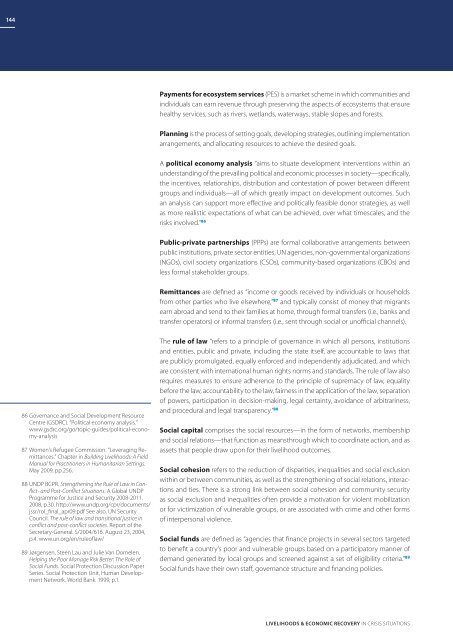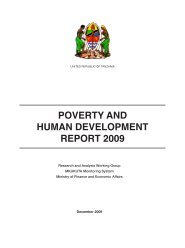Download PDF (4.08 MB) - ReliefWeb
Download PDF (4.08 MB) - ReliefWeb
Download PDF (4.08 MB) - ReliefWeb
Create successful ePaper yourself
Turn your PDF publications into a flip-book with our unique Google optimized e-Paper software.
144<br />
Payments for ecosystem services (PES) is a market scheme in which communities and<br />
individuals can earn revenue through preserving the aspects of ecosystems that ensure<br />
healthy services, such as rivers, wetlands, waterways, stable slopes and forests.<br />
Planning is the process of setting goals, developing strategies, outlining implementation<br />
arrangements, and allocating resources to achieve the desired goals.<br />
A political economy analysis “aims to situate development interventions within an<br />
understanding of the prevailing political and economic processes in society—specifically,<br />
the incentives, relationships, distribution and contestation of power between different<br />
groups and individuals—all of which greatly impact on development outcomes. Such<br />
an analysis can support more effective and politically feasible donor strategies, as well<br />
as more realistic expectations of what can be achieved, over what timescales, and the<br />
risks involved.” 86<br />
Public-private partnerships (PPPs) are formal collaborative arrangements between<br />
public institutions, private sector entities, UN agencies, non-governmental organizations<br />
(NGOs), civil society organizations (CSOs), community-based organizations (CBOs) and<br />
less formal stakeholder groups.<br />
Remittances are defined as “income or goods received by individuals or households<br />
from other parties who live elsewhere,” 87 and typically consist of money that migrants<br />
earn abroad and send to their families at home, through formal transfers (i.e., banks and<br />
transfer operators) or informal transfers (i.e., sent through social or unofficial channels).<br />
86 Governance and Social Development Resource<br />
Centre (GSDRC). “Political economy analysis.”<br />
www.gsdrc.org/go/topic-guides/political-economy-analysis<br />
87 Women’s Refugee Commission. “Leveraging Remittances.”<br />
Chapter in Building Livelihoods: A Field<br />
Manual for Practitioners in Humanitarian Settings.<br />
May 2009, pp.256.<br />
88 UNDP BCPR. Strengthening the Rule of Law in Conflict-<br />
and Post-Conflict Situations. A Global UNDP<br />
Programme for Justice and Security 2008-2011.<br />
2008, p.30. http://www.undp.org/cpr/documents/<br />
jssr/rol_final_apr09.pdf See also, UN Security<br />
Council. The rule of law and transitional justice in<br />
conflict and post-conflict societies. Report of the<br />
Secretary-General. S/2004/616. August 23, 2004,<br />
p.4. www.un.org/en/ruleoflaw/<br />
89 Jørgensen, Steen Lau and Julie Van Domelen.<br />
Helping the Poor Manage Risk Better: The Role of<br />
Social Funds. Social Protection Discussion Paper<br />
Series. Social Protection Unit, Human Development<br />
Network. World Bank. 1999, p.1.<br />
The rule of law “refers to a principle of governance in which all persons, institutions<br />
and entities, public and private, including the state itself, are accountable to laws that<br />
are publicly promulgated, equally enforced and independently adjudicated, and which<br />
are consistent with international human rights norms and standards. The rule of law also<br />
requires measures to ensure adherence to the principle of supremacy of law, equality<br />
before the law, accountability to the law, fairness in the application of the law, separation<br />
of powers, participation in decision-making, legal certainty, avoidance of arbitrariness,<br />
and procedural and legal transparency.” 88<br />
Social capital comprises the social resources—in the form of networks, membership<br />
and social relations—that function as meansthrough which to coordinate action, and as<br />
assets that people draw upon for their livelihood outcomes.<br />
Social cohesion refers to the reduction of disparities, inequalities and social exclusion<br />
within or between communities, as well as the strengthening of social relations, interactions<br />
and ties. There is a strong link between social cohesion and community security<br />
as social exclusion and inequalities often provide a motivation for violent mobilization<br />
or for victimization of vulnerable groups, or are associated with crime and other forms<br />
of interpersonal violence.<br />
Social funds are defined as “agencies that finance projects in several sectors targeted<br />
to benefit a country’s poor and vulnerable groups based on a participatory manner of<br />
demand generated by local groups and screened against a set of eligibility criteria.” 89<br />
Social funds have their own staff, governance structure and financing policies.<br />
Livelihoods & Economic Recovery in Crisis Situations





